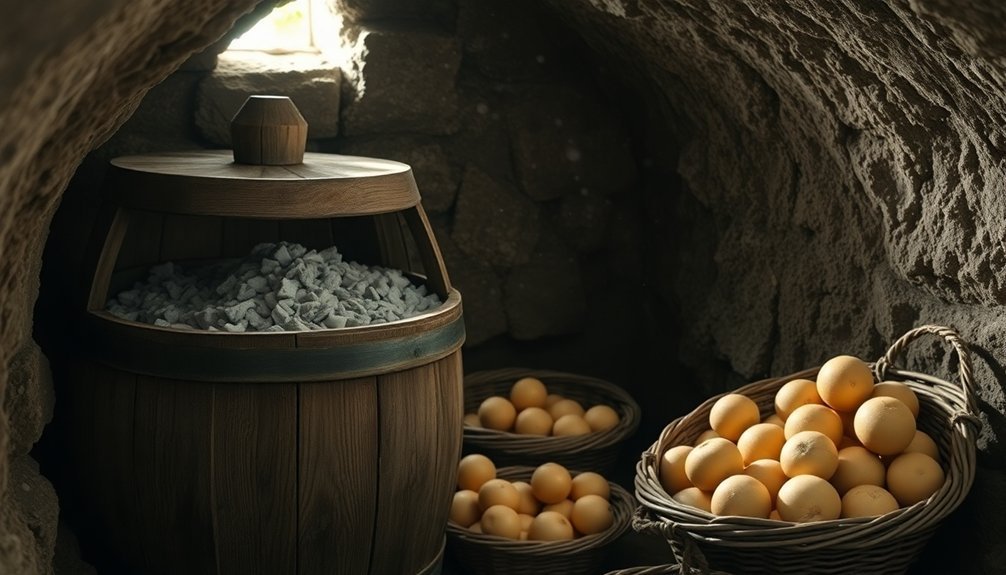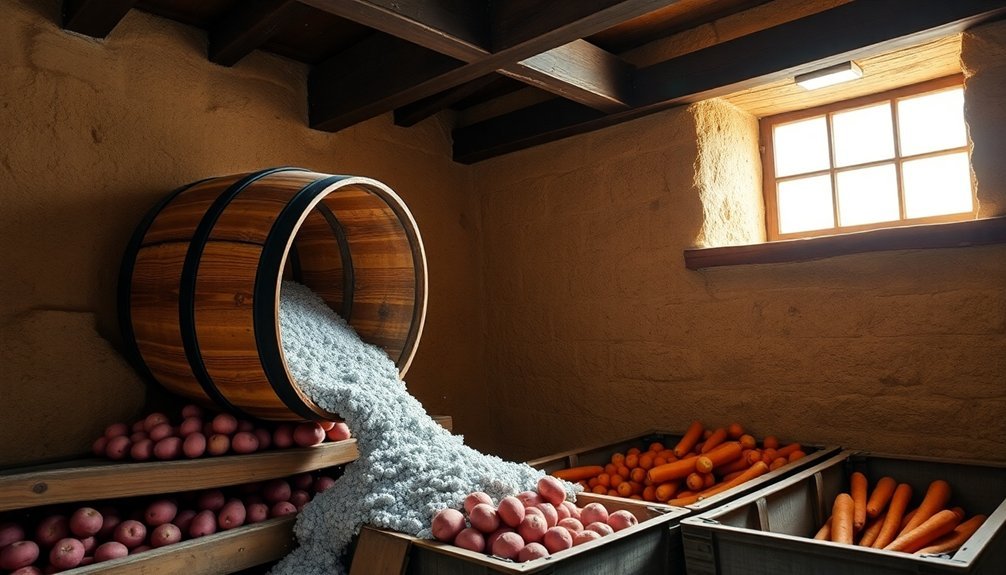You'll find wood ash offers three key benefits for keeping your root cellar fresh. First, it helps manage moisture levels when combined with dirt floors and proper ventilation, preventing excess dampness that leads to spoilage. Second, wood ash acts as an effective natural pest deterrent, creating an inhospitable barrier against slugs and other unwanted visitors that could damage your stored produce. Third, wood ash's alkaline properties help neutralize odors and maintain a clean storage environment. Understanding these natural properties of wood ash can transform your root cellar into an efficient, sustainable storage space.
Balanced Humidity With Wood Ash

Contrary to common belief, wood ash isn't an effective method for maintaining humidity in root cellars. While wood ash serves well as a natural fertilizer and soil amendment, it doesn't contribute to the moisture levels needed for proper food storage.
You'll want to focus on proven humidity control methods instead. A dirt floor naturally retains moisture better than concrete or stone, and you can enhance this effect by spreading gravel over packed earth. For maximum safety, construct your cellar with a sealed entryway design to prevent unwanted moisture fluctuations from the outside.
To boost humidity levels, you can sprinkle water directly on the floor or place pans of water throughout your cellar. For vegetable storage, try packing your produce in damp sawdust, sand, or moss to maintain ideal moisture levels.
To achieve the ideal 90-95% humidity level in your root cellar, you'll need proper ventilation with intake vents at the bottom and outlets at the top.
Make sure to elevate your storage shelves and space out your crates to allow air circulation underneath. If you're building or modifying your cellar, include adequate drainage systems to prevent water accumulation, and use proper insulation with earth cover to maintain consistent temperature and humidity levels.
Natural Pest Control
Wood ash serves as a potent natural pest deterrent in your garden, particularly against soft-bodied pests like slugs, snails, and cutworms. When you lightly dress the soil around your plants with wood ash, you'll create an uncomfortable barrier that these pests won't want to cross. The ash's high pH dries out their bodies, though you'll need to reapply after rain to maintain effectiveness.
You can expand your pest control strategy by mixing wood ash with other ingredients. Combine it with hydrated lime and water to deter cucumber beetles, or create a paste with turpentine to keep squash bugs at bay. Wearing protective gear like gloves and a mask is essential when handling ash to avoid skin and respiratory irritation. For your root vegetables, dust turnips with ash or sprinkle it in carrot drills during sowing to prevent fly infestations.
To maximize wood ash's effectiveness, integrate it with other natural pest control methods. Keep the ash dry, and don't overuse it, as excessive application can harm your plants.
You'll find it works best as part of an extensive approach that includes companion planting and regular soil testing to maintain proper pH levels. When combined with soap, wood ash can even help combat gray mold, powdery mildew, and aphids.
Fresh and Clean Storage

Successfully storing your harvest requires precise temperature and humidity control in your root cellar. You'll need to maintain temperatures between 32 and 40 degrees Fahrenheit while ensuring humidity levels stay at 90-95 percent for root vegetables. Regular monitoring with thermometers and hygrometers is essential to maintain these ideal conditions.
Proper air circulation is vital for preventing spoilage and managing condensation. You'll want to install air-intake pipes near the floor and exhaust pipes near the ceiling to create effective airflow throughout your storage space. Remember to elevate your storage crates to allow air movement underneath. Following a first in, first out system helps prevent forgotten produce from spoiling.
To maintain suitable storage conditions, consider these fundamental elements:
- Use damp sand or sawdust bedding to maintain necessary moisture levels
- Create separate storage areas for different vegetable types to control varying humidity needs
- Keep the space consistently dark to slow down vegetable respiration
- Monitor and adjust ventilation regularly to prevent ethylene gas buildup
While wood ash storage traditionally involves earthenware crockery or dug holes, modern root cellars benefit from organized storage systems using appropriate bedding materials and proper air circulation methods.
Your success depends on consistently maintaining these controlled conditions throughout the storage period.
Frequently Asked Questions
How Long Does Wood Ash Remain Effective Before Needing Replacement?
You shouldn't use wood ash in root cellars for freshness. If you're using it for other purposes like soil amendment, you'll need to reapply annually. Keep it dry for longer-term storage in separate containers.
Can Wood Ash From Different Types of Wood Affect Storage Differently?
Yes, your wood choice matters considerably. Hardwoods like maple and oak produce better preservative ash than softwoods. You'll get higher pH levels and more consistent mineral content from hardwoods, making them more effective for storage.
Is It Safe to Use Wood Ash Around Root Vegetables Intended for Eating?
You can safely use wood ash around most root vegetables you'll eat, but use it sparingly. Don't apply it near potatoes due to scab risk, and only use ash from untreated wood to avoid contamination.
What's the Ideal Thickness of Wood Ash Layer for Optimal Results?
You'll want to spread a thin, even layer of wood ash – just enough to lightly cover the surface. Don't exceed 1/8 inch thickness, as too much can create dust problems and waste materials.
How Do You Properly Store Excess Wood Ash for Future Use?
Store your excess wood ash in dry, covered containers indoors or under a tarp outdoors. Keep it away from moisture, wind, and water sources. You'll want to protect it with proper ventilation and containment.
In Summary
You'll find wood ash is a remarkable natural solution for your root cellar needs. It helps maintain ideal humidity levels, prevents unwanted pests from taking up residence, and keeps your stored produce fresh and clean. By sprinkling wood ash around your cellar and storage containers, you're using a time-tested method that's both effective and chemical-free. Give it a try – your vegetables will stay crisp longer.





Leave a Reply